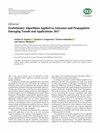Research on Electromagnetic Scattering Influence of Transmission Towers on Medium Wave Antenna Based on the Characteristic Mode Theory
IF 1.1
4区 计算机科学
Q4 ENGINEERING, ELECTRICAL & ELECTRONIC
引用次数: 0
Abstract
Electromagnetic scattering from UHV transmission towers is a major factor affecting the safety and stability of the surrounding antenna signal system. In this paper, the electromagnetic scattering effect of ±800 kV UHV DC transmission tower on the medium-wave antenna is investigated based on the characteristic mode theory (CMT). The simulation model of the tower and antenna is established, and the mode selection is carried out according to the percentage of the contribution of the characteristic mode to the total electromagnetic scattering. The effects of electromagnetic scattering under three conditions, namely, the number of towers, the distance between towers and antennas, and different frequencies, are investigated separately. The simulation results show that as the number of towers increases from 1 to 3, it leads to an increase in the electromagnetic scattering impact by about 49.5%. The shape distortion of the antenna’s directional map becomes more pronounced and is accompanied by the extension with the direction of the power line. The distance between the tower and the antenna is shortened from 500 m to 125 m, resulting in the growth of the influence of electromagnetic scattering by about 36.4%, and the directional gain of the antenna increases along the direction of the transmission line. As the frequency increases from 600 kHz to 1400 kHz, it leads to the rise of electromagnetic scattering effect of about 32.7% and the antenna directional map becomes more complicated. The research results will provide technical support for developing protective measures against electromagnetic scattering from UHV DC transmission towers to medium-wave antennas.基于特性模式理论的输电塔对中波天线的电磁散射影响研究
特高压输电塔的电磁散射是影响周围天线信号系统安全性和稳定性的主要因素。本文基于特征模态理论(CMT),研究了±800 kV 特高压直流输电铁塔对中波天线的电磁散射效应。建立了铁塔和天线的仿真模型,并根据特征模态对总电磁散射的贡献率进行了模态选择。分别研究了铁塔数量、铁塔和天线之间的距离以及不同频率这三种条件下的电磁散射效应。模拟结果表明,当铁塔数量从 1 个增加到 3 个时,电磁散射影响增加了约 49.5%。天线方向图的形状畸变变得更加明显,并随电力线方向延伸。铁塔和天线之间的距离从 500 米缩短到 125 米,导致电磁散射影响增长约 36.4%,天线的方向增益沿输电线方向增加。当频率从 600 kHz 增加到 1400 kHz 时,电磁散射影响增加了约 32.7%,天线方向图变得更加复杂。研究成果将为制定特高压直流输电塔对中波天线的电磁散射防护措施提供技术支持。
本文章由计算机程序翻译,如有差异,请以英文原文为准。
求助全文
约1分钟内获得全文
求助全文
来源期刊

International Journal of Antennas and Propagation
ENGINEERING, ELECTRICAL & ELECTRONIC-TELECOMMUNICATIONS
CiteScore
3.10
自引率
13.30%
发文量
158
审稿时长
3.8 months
期刊介绍:
International Journal of Antennas and Propagation publishes papers on the design, analysis, and applications of antennas, along with theoretical and practical studies relating the propagation of electromagnetic waves at all relevant frequencies, through space, air, and other media.
As well as original research, the International Journal of Antennas and Propagation also publishes focused review articles that examine the state of the art, identify emerging trends, and suggest future directions for developing fields.
 求助内容:
求助内容: 应助结果提醒方式:
应助结果提醒方式:


